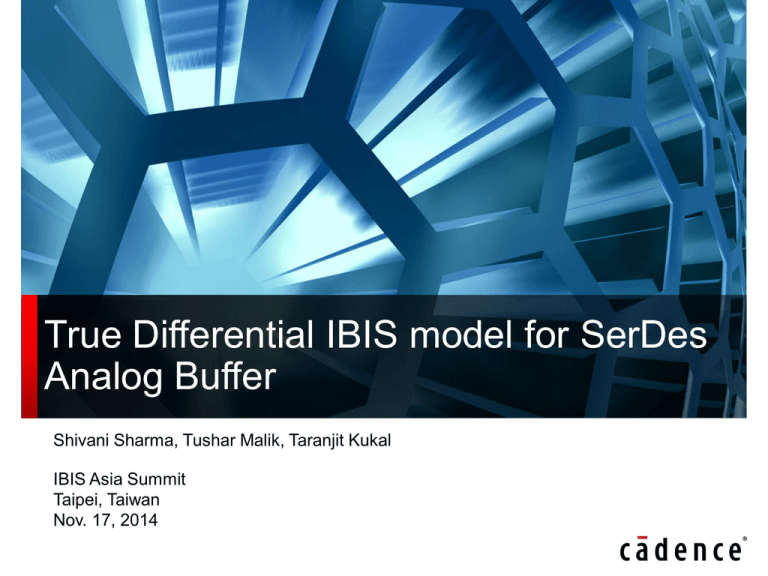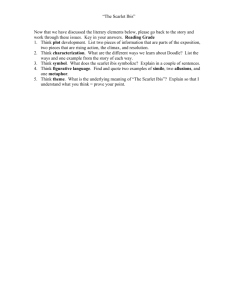
True Differential IBIS model for SerDes
Analog Buffer
Shivani Sharma, Tushar Malik, Taranjit Kukal
IBIS Asia Summit
Taipei, Taiwan
Nov. 17, 2014
Agenda
Overview of Differential IBIS
Description of test-case
Flow used to create differential IBIS model
Comparison: Pseudo-differential vs. TrueDifferential IBIS Serial-Link
Conclusion
2
© 2014 Cadence Design Systems, Inc. All rights reserved.
Agenda
Overview of Differential IBIS
Description of test-case
Flow used to create differential IBIS model
Comparison: Pseudo-differential vs. TrueDifferential IBIS Serial-Link
Conclusion
3
© 2014 Cadence Design Systems, Inc. All rights reserved.
Overview of Differential IBIS
- Current approaches
Traditionally, differential buffer have been modeled
as
− Pseudo Differential buffer using two Single-ended IBIS
models
− Accuracy can suffer if there is substantial differential current
which is the case with Serial Link analog buffers that has series
elements between PADP and PADN
− External Model approach: Call to buffer netlist
− Netlist (IP) needs to be revealed
− External Model approach: Call to S-parameter model
− Rx buffer needs to be characterized as S-parameters
4
© 2014 Cadence Design Systems, Inc. All rights reserved.
Overview of Differential IBIS
- Alternate approach
While S-parameter approach is best suited for
analog buffers in serial links, we provide an
alternate way to model it through standard IBIS
tabular format with use of series elements to
model differential current.
This extends the approach suggested in IBIS
cookbook that suggests modeling of differential
current using series Resistance.
− Here we propose use of reactive elements (R/L/C) to
model differential current.
5
© 2014 Cadence Design Systems, Inc. All rights reserved.
Agenda
− Overview of Differential IBIS
− Description of test-case
− Flow used to create differential IBIS model
− Comparison: Pseudo-differential vs. TrueDifferential IBIS Serial-Link
− Conclusion
6
© 2014 Cadence Design Systems, Inc. All rights reserved.
Description of test-case
- IBIS modeling of Serial Link RX IO
10Gbps Serial link
28nm technology node
Typical process node
Rx analog buffer had additional blocks for
equalization that were modeled as AMI code
7
Frontend attenuation
VGA
CTLE
DFE
CDR
© 2014 Cadence Design Systems, Inc. All rights reserved.
Agenda
Overview of Differential IBIS
Description of test-case
Flow used to create differential IBIS model
Comparison: Pseudo-differential vs. True-Differential
IBIS Serial-Link
Conclusion
8
© 2014 Cadence Design Systems, Inc. All rights reserved.
Flow used to create differential IBIS model
- True differential
Setup for common mode and differential mode
currents extraction
9
© 2014 Cadence Design Systems, Inc. All rights reserved.
Flow used to create differential IBIS model
- True differential
I _ Diff I AC (VDC )
I _ Comm I AC (VAC ) I AC (VDC )
-I_Diff flows through series element between inverting and non-inverting pins
-I_Comm flows only through common mode impedance
10
© 2014 Cadence Design Systems, Inc. All rights reserved.
Flow used to create differential IBIS model
- True differential buffer with series element Zseries
Zcomm
PADP
Zcomm
PADP
Zseries
Zseries
PADN
Zcomm
Tx Output Buffer
11
© 2014 Cadence Design Systems, Inc. All rights reserved.
PADN
Zcomm
Rx Input Buffer
Flow used to create differential IBIS model
- True differential buffer with series element Zseries
• Zseries and Zcomm calculated at most likely operating
frequency of buffer
• Assuming, at the most likely operating frequency of buffer,
there could be
– effective parallel RL circuit or effective parallel RC circuit between
PADP and PADN (Zseries)
– Effective L or C decided depending on sign of imaginary part of
I_Diff
• Always effective parallel RC between any pad and ground
(Zcomm)
12
© 2014 Cadence Design Systems, Inc. All rights reserved.
Flow used to create differential IBIS model
- Differential and common mode impedance calculations
VAC
• Effective Series Reactance = X series
Im( I _ Diff )
• Effective Series Resistance=
•
Rseries
VAC
Re( I _ Diff )
VAC
Effective Common mode Resistance= Ra
Re( I _ Comm)
VAC
• Effective Common mode Reactance= X a
Im( I _ Comm)
13
© 2014 Cadence Design Systems, Inc. All rights reserved.
Flow used to create differential IBIS model
- Differential and common mode impedance calculations
• For 10G serial link testcase
Rx Series Model
R=220ohms
L=9.8nH
Rx Common mode
Model
R=80ohms
C=0.223pF
Tx Common mode
Model
R=50 ohms
C=0.500pF
Tx Series Model
Assume no series model
• I_Diff and I_Comm plots for the testcase are shown next
14
© 2014 Cadence Design Systems, Inc. All rights reserved.
Common mode and differential currents
Re(I_Diff)
15
Re(I_Comm)
© 2014 Cadence Design Systems, Inc. All rights reserved.
Im(I_Diff)
Im(I_comm)
Flow used to create true-differential Rx IBIS
model
- Rx IBIS model
• Effective Parallel RL
network present as
Zseries, modeled using
“Model_type Series”
16
© 2014 Cadence Design Systems, Inc. All rights reserved.
Flow used to create true-differential Rx IBIS
model
- Rx IBIS model
• Effective Parallel RC
network present as
Zcomm, modeled using
clamp I-V table and
C_comp
17
© 2014 Cadence Design Systems, Inc. All rights reserved.
Flow used to create Tx IBIS model
- Tx IBIS model
• Effective Parallel RC
network present as
Zcomm, modeled using
Pulldown and Pullup I-V
tables and C_comp
• Assume no series
element Zseries present
18
© 2014 Cadence Design Systems, Inc. All rights reserved.
Agenda
− Overview of True Differential IBIS
− Description of test-case
− Flow used to create differential IBIS model
− Comparison: Pseudo-differential vs. TrueDifferential IBIS Serial-Link
− Conclusion
19
© 2014 Cadence Design Systems, Inc. All rights reserved.
Comparison: Pseudo-differential vs. TrueDifferential IBIS simulations
Serial Link Simulation Test-bench
−
−
−
−
10Gbps
No Equalization
PRBS23
Tested on different channels
Tx
Assuming Tx with
no series model
20
© 2014 Cadence Design Systems, Inc. All rights reserved.
Channel
Rx
Rx with series
model
Eye is seen here
Channel 1
21
Frequency
Insertion
Loss
5.15GHz
-5.861dB
© 2014 Cadence Design Systems, Inc. All rights reserved.
Channel 2
Frequency
Insertion Loss
5.1GHz
-4.14dB
22
© 2014 Cadence Design Systems, Inc. All rights reserved.
Comparison: Pseudo-differential IBIS vs. TrueDifferential IBIS vs. Circuit simulations
• Channel 1
23
© 2014 Cadence Design Systems, Inc. All rights reserved.
Comparison: Pseudo-differential IBIS vs. TrueDifferential IBIS vs. Circuit simulations
• Channel 2
24
© 2014 Cadence Design Systems, Inc. All rights reserved.
Agenda
Overview of Differential IBIS
Description of test-case
Flow used to create differential IBIS model
Comparison: Pseudo-differential vs. TrueDifferential IBIS Serial-Link
Conclusion
25
© 2014 Cadence Design Systems, Inc. All rights reserved.
Conclusion
Extended “Series Model Approach” in Cookbook
for IBIS Version 4.0 to model differential and
common-mode impedances for SERDES analog
buffer.
True differential model provides much better
accuracy than pseudo differential IBIS for
channel simulations in terms of
− Jitter and eye opening
− Reflection losses
26
© 2014 Cadence Design Systems, Inc. All rights reserved.
27
© 2014 Cadence Design Systems, Inc. All rights reserved.

